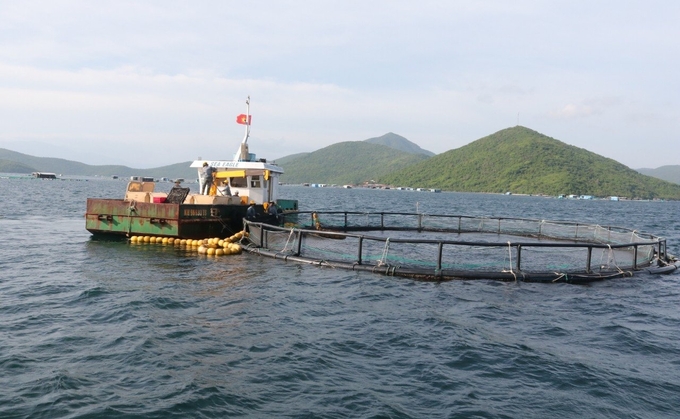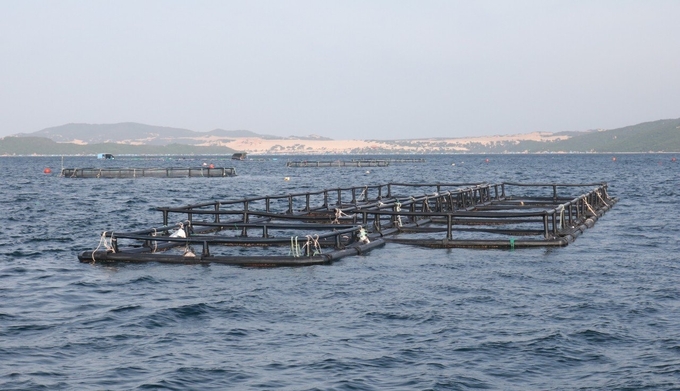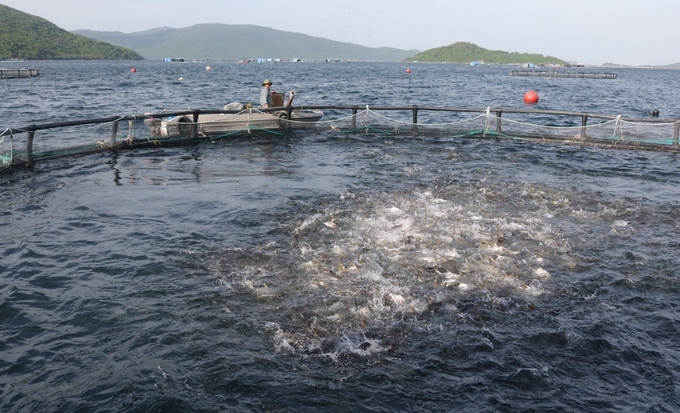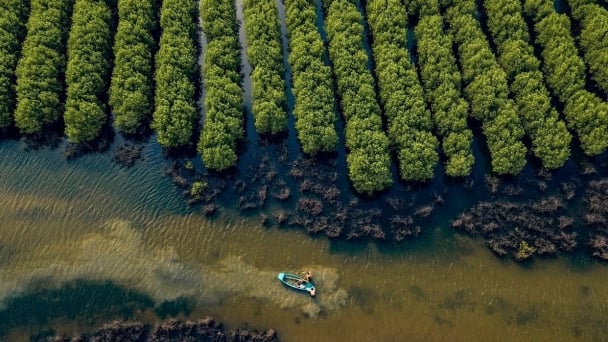June 14, 2025 | 14:35 GMT +7
June 14, 2025 | 14:35 GMT +7
Hotline: 0913.378.918
June 14, 2025 | 14:35 GMT +7
Hotline: 0913.378.918

Currently, Khanh Hoa province has a few businesses and pioneers in industrial-scale sea farming. Photo: KS.
According to Associate Professor Dr. Vo Van Nha, Deputy Director of the Research Institute for Aquaculture No 3, it is necessary to change awareness and thinking for sustainable mariculture. In particular, replicating successful examples in mariculture on an industrial scale and building advanced mariculture models for several objects with high economic value, such as marine fish, lobsters, and oysters... is necessary.
Simultaneously, promote the application of technology to serve mariculture, such as installing cage monitoring equipment, automatic environmental monitoring, smart feeding systems..., and applying 4.0 technology in aquaculture management. Therefore, to start the transformation process, businesses must participate. Businesses must be the "pioneer" to pull mariculture people towards industrial mariculture.
Also according to Associate Professor Dr. Vo Van Nha, the Ministry of Agriculture and Rural Development currently has a typical example in chain linkage, a program to build a linkage model in lobster production and consumption. In particular, businesses are essential to providing input products, including materials, breeds, food..., and consuming output products.
Not only lobsters, other potential target groups such as marine fish, mollusks, and seaweed... will also be the target of forming chain links in the near future. And so, businesses in these linked chains always play a significant role. However, the most important thing is to improve mechanisms and policies to attract companies to invest in both "input products" and "output products" in the field of mariculture.
The agricultural sector in the South Central provinces is reorganizing the small, dispersed mariculture system into other forms with community participation, cooperatives, or businesses. Along with that is the formation of information channels in the market, promptly providing mariculture facilities with market and price information so that farming facilities can proactively produce and reduce risks.

Marineculture using HDPE cages is both environmentally friendly and adaptable to natural disasters. Photo: KS.
According to Mr. Nguyen Duy Quang, Director of Khanh Hoa Department of Agriculture and Rural Development, several industrial mariculture models have been formed in the province in recent years. Khanh Hoa is one of the early localities to access mariculture technology on an industrial scale using HDPE cages and has businesses participating in mariculture.
Also, according to Mr. Quang, since the 2000s, in Khanh Hoa, Pearl Company Limited has invested in raising marine fish using HDPE round cages in Van Thanh commune (Van Ninh district). Next, in 2006-2007, Marine Farms ASA Vietnam Co., Ltd. (Norway) and Australis Vietnam Fisheries Co., Ltd. began investing in equipment and technology for raising marine fish with industrial-scale HDPE cages in the bay. Van Phong. By 2013, the Research Institute for Aquaculture No1 implemented an industrial-scale mariculture demonstration project on Van Phong Bay. These are the pioneering units and businesses doing mariculture on an industrial scale using HDPE cages at sea in Khanh Hoa.
Australis Vietnam Seafood Company Limited (100% foreign capital) specializes in raising seabass using Norwegian technology with a scale of 70 HDPE cages divided into 5 farms. Each cage has a circumference of 120m, achieving an average output of 250-300 tons of fish, and annual output reaches 6,000-8,000 tons. In addition to commercial farming, this company also has a system of fish hatcheries, harvesters, processors, and direct exports to the US, Australia, Korea, and Japan.

Yellowfin pompano farming model of the Research Institute for Aquaculture No 1. Photo: KS.
Changing farming materials from traditional wooden cages to HDPE cages that can withstand storms helps keep aquaculture safe during stormy seasons. In addition, industrial-oriented mariculture businesses invest in modern technology and high-quality farmed seafood to dominate the market, convince consumers, and have stable output. In particular, the more sustainable production activities are for mariculture businesses with access to major markets worldwide.
In the coming time, mariculture businesses need to establish cooperation with Institutes, Schools, and Internationalities to train human resources to serve management, research, and production for mariculture, Participate in domestic and regional organizations and industry associations related to mariculture activities so that the mariculture industry can reach out sustainably.
In particular, in mariculture water surface planning, the functional sector needs specific planning to grasp the output, thereby organizing production accordingly. Businesses coordinate with functional agencies to find product consumption partners or participate in seafood fairs to promote products and proactively produce output. That is a critical issue because once we move towards industrial mariculture, output will increase significantly, and product output will become a top priority.
Translated by Tuan Huy

(VAN) In Tien Giang, a high-tech shrimp farm has developed a distinctive energy-saving farming model that has yielded promising results.
![Turning wind and rain into action: [3] 300.000 farmers benefit from agro-climatic bulletins](https://t.ex-cdn.com/nongnghiepmoitruong.vn/608w/files/news/2025/06/12/e5a48259d6a262fc3bb3-nongnghiep-125122.jpg)
(VAN) The agro-climatic bulletin has become a valuable tool for farmers in the Mekong Delta. After more than five years of implementation, the initiative is gradually being expanded nationwide.
![Turning wind and rain into action: [2] Providing forecasts to the people](https://t.ex-cdn.com/nongnghiepmoitruong.vn/608w/files/news/2025/06/12/e5a48259d6a262fc3bb3-nongnghiep-103927.jpg)
(VAN) In addition to improving the quality of hydrometeorological forecasts, putting forecast bulletins into practical use is crucial for production and disaster prevention.

(VAN) Blue carbon is receiving attention for its rapid absorption capacity and vast potential. It represents a promising nature-based solution to respond to climate change.
/2025/06/11/3507-1-161904_583.jpg)
(VAN) Seagrass beds and coral reefs serve as 'cradles' that nurture life in the ocean depths, creating rich aquatic resources in Vietnamese waters.
![Turning wind and rain into action: [1] Forecasting for farmers](https://t.ex-cdn.com/nongnghiepmoitruong.vn/608w/files/news/2025/06/11/e5a48259d6a262fc3bb3-nongnghiep-111919.jpg)
(VAN) Weather is no longer just a matter of fate. Forecasts have now become an essential companion for farmers in every crop season.
/2025/06/10/2501-3-082025_983.jpg)
(VAN) Mr. Le Hoang Minh, Head of Vinamilk's Net Zero project, recently shared insights on the integration of production, energy, and technology in Vinamilk’s green transition journey.